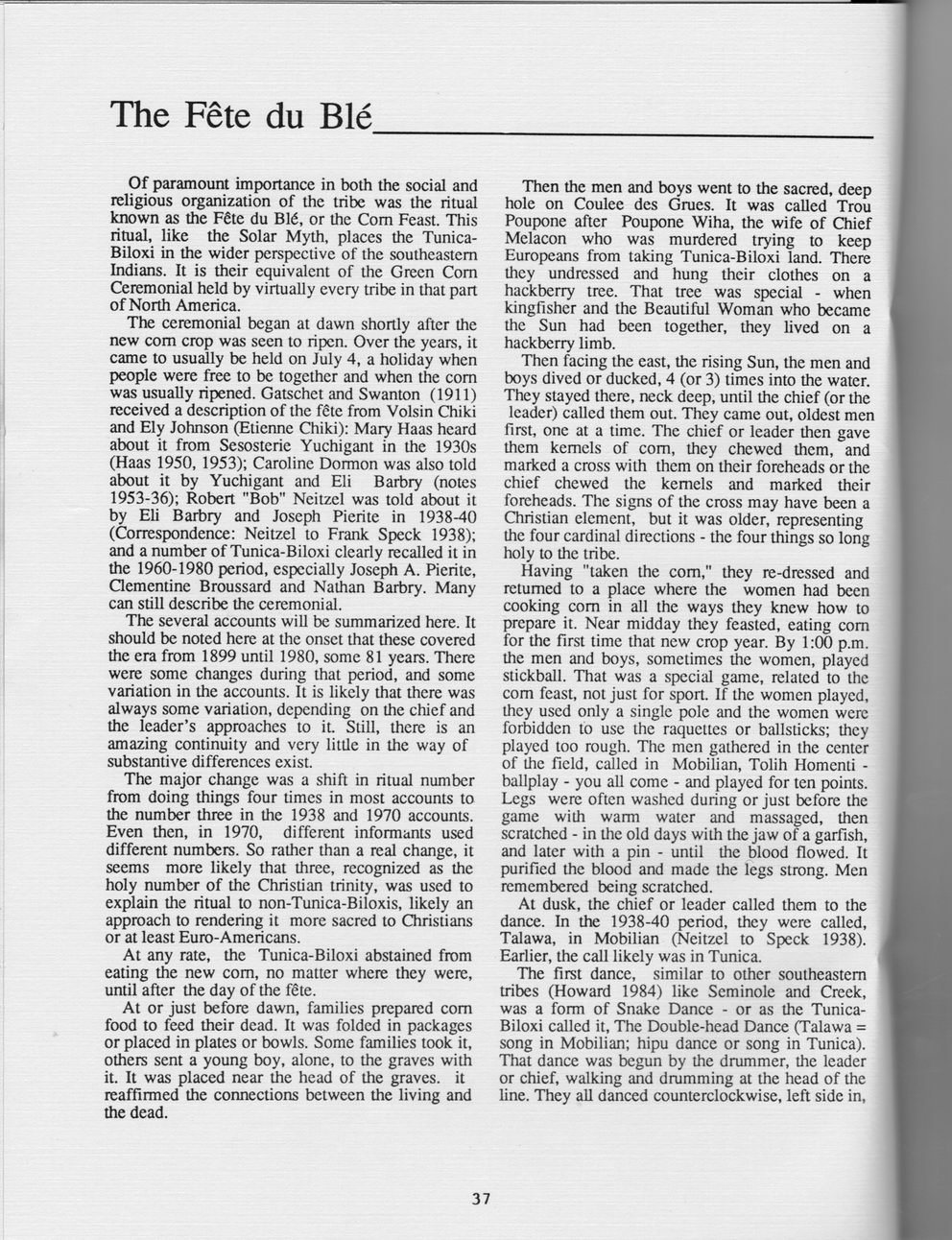This text was obtained via automated optical character recognition.
It has not been edited and may therefore contain several errors.
The Fete du Ble Of paramount importance in both the social and religious organization of the tribe was the ritual known as the FSte du Bid, or the Com Feast. This ritual, like the Solar Myth, places the Tunica-Biloxi in the wider perspective of the southeastern Indians. It is their equivalent of the Green Com Ceremonial held by virtually every tribe in that part of North America. The ceremonial began at dawn shortly after the new com crop was seen to ripen. Over the years, it came to usually be held on July 4, a holiday when people were free to be together and when the com was usually ripened. Gatschet and Swanton (1911) received a description of the fete from Volsin Chiki and Ely Johnson (Etienne Chiki): Mary Haas heard about it from Sesosterie Yuchigant in the 1930s (Haas 1950, 1953); Caroline Dormon was also told about it by Yuchigant and Eli Barbry (notes 1953-36); Robert "Bob" Neitzel was told about it by Eli Barbry and Joseph Pierite in 1938-40 (Correspondence: Neitzel to Frank Speck 1938); and a number of Tunica-Biloxi clearly recalled it in the 1960-1980 period, especially Joseph A. Pierite, Clementine Broussard and Nathan Barbry. Many can still describe the ceremonial. The several accounts will be summarized here. It should be noted here at the onset that these covered the era from 1899 until 1980, some 81 years. There were some changes during that period, and some variation in the accounts. It is likely that there was always some variation, depending on the chief and the leader’s approaches to it. Still, there is an amazing continuity and very little in the way of substantive differences exist. The major change was a shift in ritual number from doing things four times in most accounts to the number three in the 1938 and 1970 accounts. Even then, in 1970, different informants used different numbers. So rather than a real change, it seems more likely that three, recognized as the holy number of the Christian trinity, was used to explain the ritual to non-Tunica-Biloxis, likely an approach to rendering it more sacred to Christians or at least Euro-Americans. At any rate, the Tunica-Biloxi abstained from eating the new com, no matter where they were, until after the day of the fete. At or just before dawn, families prepared com food to feed their dead. It was folded in packages or placed in plates or bowls. Some families took it, others sent a young boy, alone, to the graves with it. It was placed near the head of the graves, it reaffirmed the connections between the living and the dead. Then the men and boys went to the sacred, deep hole on Coulee des Grues. It was called Trou Poupone after Poupone Wiha, the wife of Chief Melacon who was murdered trying to keep Europeans from taking Tunica-Biloxi land. There they undressed and hung their clothes on a hackberry tree. That tree was special - when kingfisher and the Beautiful Woman who became the Sun had been together, they lived on a hackberry limb. Then facing the east, the rising Sun, the men and boys dived or ducked, 4 (or 3) times into the water. They stayed there, neck deep, until the chief (or the leader) called them out. They came out, oldest men first, one at a time. The chicf or leader then gave them kernels of com, they chewed them, and marked a cross with them on their foreheads or the chief chewed the kernels and marked their foreheads. The signs of the cross may have been a Christian element, but it was older, representing the four cardinal directions - the four things so long holy to the tribe. Having "taken the com," they re-dressed and returned to a place where the women had been cooking com in all the ways they knew how to prepare it. Near midday they feasted, eating com for the first time that new crop year. By 1:00 p.m. the men and boys, sometimes the women, played stickball. That was a special game, related to the com feast, not just for sport. If the women played, they used only a single pole and the women were forbidden to use the raquettes or ballsticks; they played too rough. The men gathered in the center of the field, called in Mobilian, Tolih Homcnti -ballplay - you all come - and played for ten points. Legs were often washed during or just before the game with warm water and massaged, then scratched - in the old days with the jaw of a garfish, and later with a pin - until the blood flowed. It purified the blood and made the legs strong. Men remembered being scratched. At dusk, the chief or leader called them to the dance. In the 1938-40 period, they were called, Talawa, in Mobilian (Neitzel to Speck 1938). Earlier, the call likely was in Tunica. The first dance, similar to other southeastern tribes (Howard 1984) like Seminole and Creek, was a form of Snake Dance - or as the Tunica-Biloxi called it, The Double-head Dance (Talawa = song in Mobilian; hipu dance or song in Tunica). That dance was begun by the drummer, the leader or chief, walking and drumming at the head of the line. They all danced counterclockwise, left side in, 37

Native Americans The-Tunica-Biloxi-Tribe-its-Culture-and-People-(46)